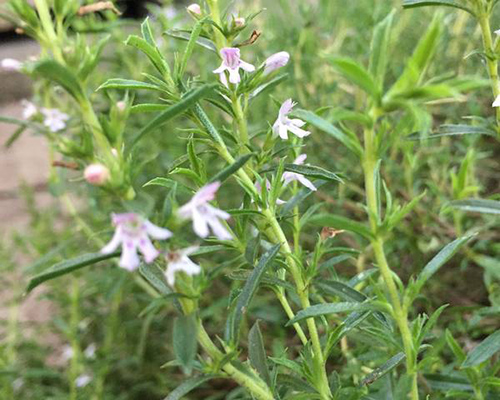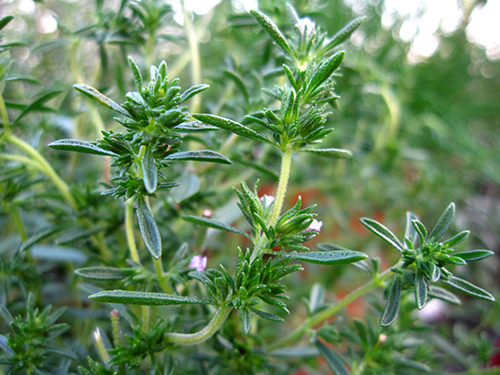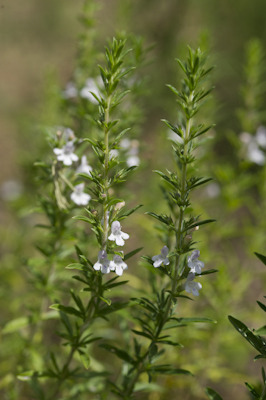Contents
Winter savory is a genuinely sensual plant. Its intense aroma seems to prove it. It is not strange, thus, that for ages, its seasoning and aphrodisiac virtues were known. It is said that ancient Greeks dedicated this plant to the god Dionysus, called Bacchus by the Romans. Many orgiastic festivals were celebrated in honor of this plant. Winter savory encourages digestion and promotes vital functions. The Middle Ages monks were not allowed to cultivate this plant in their gardens. In Mediterranean areas, especially in Andalusia, one of the typical dishes is olives seasoned with winter savory.

Healing Properties and Indications
Winter savory contains up to one percent of an essential oil rich in carvacrol and cymol, which gives the plant stimulant, carminative, antispasmodic, vermifuge, diuretic, and pectoral properties. The oil also contains tannin and polyphenolic substances.
- The plant also features appetizer properties and serves to ease digestion. Moreover, its carminative properties are interesting. According to Font Quer, the outstanding Spanish pharmacist and botanist, winter savory “fights the winds of the stomach and intestine.” There’s nothing better than winter savory to-season dishes. Besides, it relaxes the intestine muscles (antispasmodic properties), thus beneficial for abdominal spasms and diarrhea. It is recommended for people suffering from gastritis, and it also presents some vermifuge properties.
- It offers mild stimulating properties for the nervous system, making it recommended for chronic fatigue, weakness, low blood pressure, and asthenia. Of course, this plant must be used with other natural treatments as a reinvigorating cure.
- Its aphrodisiac properties are not overwhelming and dramatic but discrete and progressive. Winter savory should be combined with other plants when a more vigorous action is wanted.
- It is mildly diuretic and depurative and is thus recommended for people suffering from obesity, arthritis, and gout.
- Because of its essential oil, winter savory has balsamic and expectorant properties. Thus, it is helpful for acute and chronic bronchitis and asthma.

Summer Savory
There are several savory species, all similar in composition and properties. One of them is summer savory, sometimes called oregano and marjoram. Besides its medicinal properties, summer savory is cultivated because of its leaves, which serve as seasoning. The essence is also a valued seasoning.
White savory grows in Catalonia, Spain. Delicate or tiny savory is also found in Mediterranean Spanish nations.
Winter Savory Recipes

- Winter savory recipes include stews, which can be used both fresh and dry, and even ground utilizing a pepper mill. Its essence is also used as a seasoning.
- This recipe has a long tradition in southern Spanish villages as a seasoning for raw olives. Olives are put in water for some days, and the water is changed until it is clear, and the olives lose their sour flavor. Then, put the olives in water and add savory (a handful per liter), salt, garlic, and orange rind (in the case of black olives) or lemon rind (in the case of green olives). Satisfaction is guaranteed.
Winter Savory Scientific Facts
- French: Sariette.
- Spanish: Ajedrea.
- Environment: Though native to the Mediterranean areas of Europe, this plant is currently widespread in warm regions all over Europe and America. It better resists dry, sunny climates.
- Description: Shrub, growing up to 25-30 cm high, of the Labiatae family. Winter savory calls attention because of its aroma in any place. It has delicate, point-tipped leaves with small holes in which the essence-producing glands are housed. The flowers are small, pink or white, and divided into two lips.
- Parts of the plant used medicinally: leaves, flowers, and stems.
How to use Winter Savory
- Infusion with 20 g of plant per liter of water. Drink up to three or four cups daily.
- Essence. The recommended dose is from three to five drops after every meal.
DISCLAIMER: All content on this website is presented solely for educational and informational objectives. Do not rely on the information provided as a replacement for advice, diagnosis, or treatment from a qualified medical expert. If you are pregnant, nursing, or have any preexisting medical concerns, talk to your doctor before using any herbal or natural medicines.
REFERENCES
- George D. Pamplona-Roger, M.D. “Encyclopedia of Medicinal Plants.” George D. Pamplona-Roger, M.D. Encyclopedia of Medicinal Plants. Ed. Francesc X. Gelabert. Vols. 1 San Fernando de Henares: Editorial Safeliz, 2000. 374, 375. Print.
- PubMed https://pubmed.ncbi.nlm.nih.gov/
